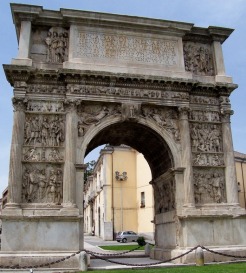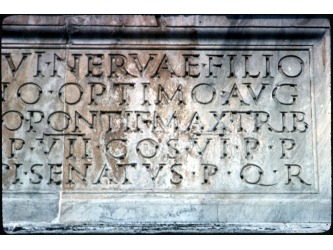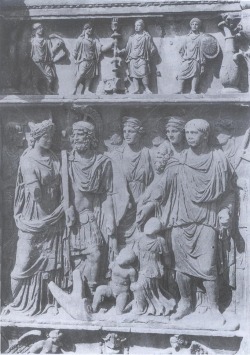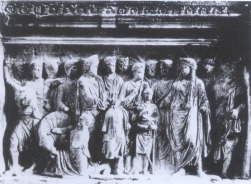Arch of Trajan

The Trajan Arch is the most prominent structure from antiquity still found in Beneventum and definitely its most famous ancient landmark. The arch was built in 114 A.D. to commemorate the completion of the Via Trianna [1], but, more importantly, serves the great purpose of glorifying the emperor, Trajan, while also demonstrating some of his practices at the time, especially in regard to imperialism and the role of children in the empire, often times blending the two [2].
Latin Inscription: [v][3]
IMP(eratori) CAESARI DIVI NERVAE FILIO NEVRAE TRAIANO OPTIMO AVG(usto) GERMANICO DACIO PONTIF(ici) MAX(imo) TRIB(unicia) POTEST(ate) XVIII IMP(eratori) VII CO(n) S(uli) VI P(atri) P(atriae) FORTISSIMO PRINCIPI SENATVS P(opulus) Q(ue) R(omanus)
English Translation:
To the emperor, son of the Divine Nerva, Nerva Trajan Augustus Germanicus Dacicus, Chief Priest, Father of the Country, with Tribunician Power for the Eighteenth Year, Imperator for the Seventh Time, Consul for the Sixth Time, the Senate and the People of Rome dedicated to this.
Imperialism on the Arch

One of the most common themes found on the arch is the Roman Empire's need to expand. Almost all of the reliefs were tied into the concept of how the Roman Empire would continue to grow to encompass all of Italy, and eventually the Mediterranean. The two sides of the arch depicted different aspects of the imperialism. The reliefs on the south-west side (facing the town) dealt with civilian affairs, showing the rewards which came from conquering land such as good supply routes and land for veterans. It also raised Trajan to godlike status, shown by gods awaiting his arrival. The north-east side (facing the country), however, dealt with military affairs, showing the necessity for future troops and showing superiority after being victorious in the Dacian Wars by having Dacian gods bow down before Trajan [4]. A theme found on the arch is that of the four seasons where Spring and Summer are found on the town side, paired with winged victories, symbolizing their power of the newly conquered people, while the country side shows Autumn and Winter. They are accompanied by river deities to symbolize the resources now available from the newly conquered land. The entirety of the frieze circling the arch is a testament to Trajan’s victory as an imperial leader, depicting a triumphal procession of 107 people to commemorate Trajan’s conquering of the Dacians [5] (a portion of the frieze is pictured above [i]).
Children on the Arch

The Arch of Trajan is also quite notable for its representation of children. Relative to other works of the time, the children on the arch are shown with far more importance, especially in how they are pivotal to the growth of the empire[6]. Children are shown in a variety of manners, from slaves of the conquered barbarians to future citizens and soldiers, and even to eternal representations of the four seasons[7]. The children are most frequently depicted in the reliefs of the arch to demonstrate the alimenta system. This system allowed for Italian families in large cities, such as Beneventum, to be subsidized for having children [8](Picture Above [ii]). Children are also frequently shown with Trajan, showing him as a nurturing and protective father. On the flip side, however, Trajan also offers children up as to the gods [9](Picture Below Left [iii]) This scene is ripe with symbolism, from the gods Mars and Italia to whom Trajan is offering to the deities located in the background, Liberalitas (Generosity) and Felicitas (Prosperity). Children also assist Trajan in the sacrifice scene by assuming the role of camillus.[10] (Picture Below Right [iv]) All of these scenes show the children as an essential part of the empire, both as political tools and through religious practices.
[1] Elsner, Jas. 1996. Art and Text in Roman Culture. New York: Cambridge University Press. Page 153.
[2] ibid. Page 181.
[3] ibid. Page 162.
[4] ibid. Page 165.
[5] ibid. Page 174.
[6] ibid. Page 162.
[7] ibid. Page 181.
[8] ibid. Page 169.
[9] ibid. Page 178.
[10] ibid. Page 180.
[i] Buitron-Oliver, Diana. 1997. The Interpretation of Architectural Scultpture in Greece and Rome. Maryland: Schneidereith & Sons. Page 164.
[ii] ibid. Page 148.
[iii] ibid. Page 153.
[iv] ibid. Page 149.
[v] http://commons.wikimedia.org/wiki/Benevento
[inset within paragraph] ibid




